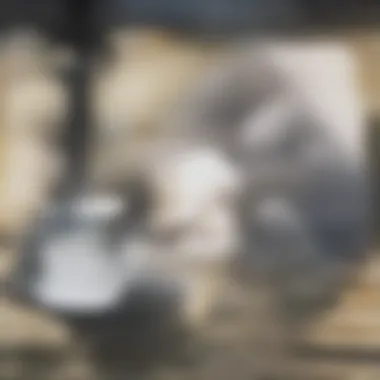Best Way to Wash Outside Windows Without Streaks


Intro
Washing outside windows can be a daunting task for many homeowners. However, achieving streak-free windows is key to maintaining both the aesthetic appeal of a home and its functional clarity. This guide serves to detail methods, tools, and techniques that can help you achieve optimal results when cleaning outside windows. By understanding the right cleaning solutions and timing, as well as honing the appropriate techniques, individuals can enhance the cleaning process significantly. The following paragraphs will elucidate the best practices for washing outside windows without leaving unsightly streaks.
Effective Cleaning Solutions
When it comes to cleaning windows, the solution used plays a crucial role. Many store-bought products exist, but some homeowners prefer homemade alternatives. Vinegar and water is a classic combination that can leave windows sparkling without the use of harsh chemicals. An ideal mixture is equal parts vinegar and water, which effectively cuts through grime while being environmentally friendly.
Another robust option is dish soap mixed with water. A drop or two of dish soap in a bucket of water ensures a gentle yet effective clean. For those seeking convenience, commercially available glass cleaners like Windex can also deliver streak-free shine, provided they are used correctly.
Timing Matters
Choosing the right time to wash windows can influence the outcome. Ideally, cloudy days are the best for this chore. Sunlight can cause cleaning solutions to dry too quickly, leading to streaks. By cleaning when it’s overcast, solutions have adequate time to act before drying up. Early morning or late afternoon are other suitable times, as they avoid the direct harsh light found at midday.
Tools for Success
An array of tools can enhance window washing efficiency. Consider the following:
- Squeegee: A high-quality rubber squeegee helps remove cleaning solution quickly and effectively.
- Microfiber Cloths: These cloths trap dirt without leaving lint behind, making them ideal for a final wipe-down.
- Extension Pole: This tool extends your reach, allowing you to clean upper windows without the use of a ladder.
- Bucket: A sturdy bucket for mixing your cleaning solution is essential.
Technique is Key
Having the right tools is only part of the process. The correct technique can make or break your window washing efforts. Here are a few practices to follow:
- Begin at the top of the window and work your way down. This ensures that any runoff does not dirty areas you’ve already cleaned.
- Use a squeegee in a straight motion, wiping the blade with a microfiber cloth between strokes to avoid streaks.
- Finish by wiping edges and corners with a cloth to catch any drips.
"The right method and timing can transform your window washing experience, producing results that enhance the beauty of your home."
Maintaining windows in pristine condition not only contributes to the attractiveness of a home but can also increase its longevity. Regular cleaning prevents the buildup of grime that can damage window surfaces in the long run. Following these outlined steps ultimately equips homeowners with the knowledge needed to tackle window washing effectively.
Understanding Window Cleaning
Clean windows do more than just let in light. They enhance the overall aesthetic and ambiance of a space. This element is especially crucial for homeowners looking to make a positive impression, whether for personal enjoyment or for visitors. A clear view outside can improve not only mood but also the perceived value of a property. This section outlines what makes window cleaning essential and the common pitfalls that lead to streaks.
Importance of Clean Windows
Clean windows contribute significantly to the charm of a property. They allow natural light to flood in, illuminating interiors and creating a sense of openness. Neglected windows can gather dust, dirt, and grime, which masks the beauty of the outdoors. A well-maintained window provides a clear view, transforming ordinary spaces into exceptional ones. Moreover, the upkeep of your windows extends their life.
An engaging atmosphere encourages productivity and comfort within the home. For homeowners selling their properties, clean windows are an asset that can help facilitate better sales. The visible cleanliness reflects the overall care put into maintaining a home, raising appeal to potential buyers. Windows deserve thoughtful attention as part of any home maintenance routine.
Common Causes of Streaks
Streaks can diminish the effect of clean windows. Understanding the root causes is the first step to preventing them. Common factors include:
- Using the wrong cleaning solutions: Some solutions lead to residue that causes streaks after drying. Always opt for products specifically designed for glass.
- Improper cleaning technique: Applying too much pressure can lead to uneven cleaning and streaking.
- Dirt and debris: Failing to remove larger particles before applying solutions can scratch the glass, leading to streaks and marks.
- Environmental conditions: Cleaning windows in direct sunlight or excessive heat can cause the solution to evaporate too quickly, resulting in streaks.
"Understanding the factors that contribute to streaking is crucial for any successful cleaning approach."
It is important to approach window cleaning with care. By realizing why streaks occur, one can effectively take measures to achieve that desired, streak-free shine. This knowledge lays the foundation for mastering window cleaning techniques, ensuring windows remain clear and inviting.
Preparation for Window Washing
Preparing for window washing is crucial for achieving a streak-free shine on your outside windows. Proper preparation not only enhances effectiveness but also minimizes time spent on the task. A thoughtful approach can lead to noticeably better results, which will increase the enjoyment of your clean windows.
Choosing the Right Time
Choosing the right time to wash windows can greatly influence the outcome. The timing affects how quickly the cleaning solution dries and its capacity to remove dirt effectively.
Weather Considerations


Weather is a significant factor in planning your window-washing day. It is best to pick a day that is overcast and dry. Direct sunlight can cause the cleaning solution to dry too quickly, leaving streaks behind.
- Key Characteristic: Overcast conditions provide a cooler environment, allowing the cleaning solution to work more effectively before air drying.
- Advantages: A well-timed wash can result in clearer results because streaks are less likely to form. It also reduces the chances of heat-related issues that could hinder your efforts.
- Disadvantages: Rainy days are obviously not ideal as they can lead to work being undone shortly after washing.
Sunlight and Heat Effects
Sunlight and heat can impact the efficacy of your cleaning process. When temperatures are high, direct sun on windows holds heat which can evaporate cleaning solutions too fast.
- Key Characteristic: Heat promotes fast drying which creates spots, streaks, and residue.
- Advantages: Avoiding sunlit windows can lead to a more thorough clean as the solution has time to dissolve grime and dirt.
- Disadvantages: Sometimes, sunny days may appear ideal for bright light, making it tempting to clean them even if it is not recommended.
Essential Tools and Supplies
Having the right tools for the job is essential. Each tool contributes to an efficient and effective cleaning process. Using high-quality tools can make a substantial difference in the end results.
Squeegees
A squeegee is paramount in achieving a streak-free finish. It effectively removes excess water and cleaning solution from window surfaces.
- Key Characteristic: A good squeegee has a sturdy rubber blade designed to reduce streaking.
- Advantages: It helps to quickly pull moisture off the glass, leaving a clear surface behind. A proper squeegee prevents liquid pooling and minimizes the chances of stains forming.
Buckets
Buckets are necessary to hold cleaning solution and water effectively. You will need at least two buckets if using the two-bucket method.
- Key Characteristic: Buckets should be of a suitable size to fit the tools you have and avoid spilling.
- Advantages: Having a designated space for solutions keeps things organized and racing stains back to the toolbox can become easier.
Microfiber Cloths
Microfiber cloths are excellent for detailing. These towels hold water and cleaning solutions effectively without scratching the glass.
- Key Characteristic: The fibers trap dirt, dust, and other debris, pulling them away from the glass surface.
- Advantages: They ensure a flawless finish and can be reused many times, making them an economical choice for window cleaning.
Cleaning Solutions
The cleaning solution plays a critical role in removing dirt and grime. It’s vital to choose effective and safe options that are suited for window glass.
- Key Characteristic: Effective solutions break down grease and dirt without leaving a residue.
- Advantages: They streamline the cleaning process, ensuring little to no streaks form during drying, whether it be commercial or homemade solutions.
It is important to choose the right time and tools for window washing to achieve the best results without streaks.
Different Window Cleaning Techniques
Understanding different window cleaning techniques is essential for achieving streak-free glass. The methods you choose can make a significant difference in the final outcome. Selecting the right technique can enhance efficiency and ensure that your windows are both functional and visually appealing.
The Two-Bucket Method
Step-by-Step Process
The Two-Bucket Method is a structured approach to window cleaning that prioritizes cleanliness and effectiveness. This method involves using two buckets: one filled with clean water and the other with soapy water. First, gather your supplies, including a squeegee, a cleaning solution, cloths, and the two buckets.
- Fill one bucket with warm water and your chosen cleaning solution.
- Fill the second bucket with plain water to rinse your tools.
- Start by dipping your cleaning cloth in the soapy solution and wipe the window to remove dust and dirt.
- After wiping, use the squeegee to remove the excess water, rinsing it in the second bucket as needed.
- Repeat the process until the window is clear.
The key characteristic of this technique is that it minimizes the risk of transferring dirt back onto the window. Therefore, it is beneficial for achieving a clear finish. A notable feature of this method is its ability to keep water separate, contributing to a streak-free surface. However, it does require additional equipment, which may be seen as a disadvantage by some individuals.
Advantages of the Method
The advantages of the Two-Bucket Method are numerous. It maintains a high standard of cleanliness by ensuring that the water used to clean is not contaminated with dirt. This method is widely considered the most effective for large windows or multiple panes. Its unique feature lies in the dual-bucket system, allowing for a more thorough clean than singular methods. Despite needing more resources, the dramatic improvement in clarity often justifies this.
Using a Squeegee


Handling and Technique
Squeegees are valuable tools in window cleaning, and proper handling is crucial. To effectively use a squeegee, maintain a comfortable grip and apply even pressure while moving it across the glass. The key characteristic of using a squeegee is that it removes water, allowing for quick drying and reducing streaks. This technique, when done well, makes it a popular choice for professional window cleaners.
The unique feature of the squeegee is its ability to quickly cover large surface areas with minimal hassle. However, improper technique can lead to streaks or missed spots.
Common Mistakes
When using a squeegee, common mistakes can undermine the results. For instance, starting with a dry glass or not rinsing the squeegee often can lead to streaks. Another frequent error is using a squeegee on heavily soiled windows without sufficient cleaning beforehand. Understanding these key characteristics of Common Mistakes helps avoid pitfalls during the cleaning process. Recognizing these missteps and adjusting techniques can significantly improve window clarity.
Available Commercial Solutions
Comparing Brands
There are many commercial cleaning solutions available for window cleaning, and comparing brands can assist in making an informed choice. Some solutions prioritize eco-friendliness, while others boast specific streak-free formulas. Each brand may have its unique formulation, impacting effectiveness. The key characteristic of comparing brands lies in understanding their performance on different glass types. Researching reviews and recommendations can highlight strengths and weaknesses against each other, helping you find what works best for your needs.
DIY Solutions vs. Store-Bought
Deciding between DIY solutions and store-bought cleaners can be a personal choice. Homemade cleaners, often made from vinegar or baking soda, can be effective and economical. On the other hand, commercial cleaners can offer convenience and specific formulations for glass care. The key advantage of DIY solutions is knowing exactly what goes into them, enabling customization based on your preferences. The unique feature of store-bought cleaners, however, is their developed formulas, designed to tackle various grime and dirt types efficiently.
Steps to Wash Outside Windows
Washing outside windows is not just about aesthetics. It's about improving the clarity and functionality of your view. A clear window lets in light, increases visibility, and can even affect the vibes of a room. By learning the correct methods to wash your windows, you can eliminate streaks and enhance the overall appearance of your home. Moreover, maintaining clean windows prevents prolonged dirt accumulation, which can lead to more complex cleaning tasks over time.
Aside from impacting the look of your home, effective window washing also ensures that the natural light can filter through unobstructed. This can be particularly important for those working from home or engaging in hobbies where light quality matters. Therefore, the steps that follow are critical for achieving the best results.
Gathering Your Supplies
Before embarking on the window cleaning process, it is vital to gather all necessary supplies. Having these items ready ensures efficiency and effectiveness during cleaning. Below is a list of supplies you may consider:
- Squeegee
- Buckets
- Microfiber cloths
- Window cleaning solutions
- Scrubbers or sponges
Select a cleaning solution that is appropriate for the surfaces you will treat. This could be a commercial cleaner or a homemade mix, such as equal parts water and vinegar. Organize your supplies within easy reach to streamline the cleaning process.
Initial Dusting and Cleaning
Once you have the supplies ready, the next step involves initial dusting and cleaning. This preparatory action is essential for preventing debris from scratching the glass during the washing process. You can follow these steps for effective initial cleaning:
- Remove loose dirt and dust. Use a dry microfiber cloth or a duster for this task.
- For larger debris, consider using a soft-bristle broom or a handheld vacuum.
- Pay special attention to the window frames, as dirt may accumulate there and transfer during the washing.
By initiating cleaning this way, you will ensure that your main cleaning method is more efficient.
Applying Cleaning Solution
After the initial dusting, it's time to apply the cleaning solution. It's important to apply the solution evenly on the window surfaces to avoid streaks. Here are some tips:
- Use a spray bottle for more controlled application.
- Spray the cleaning solution generously across the glass surface.
- If using a bucket, dip a scrubber or sponge into the solution and spread it evenly starting from the top and working your way down.
Allow the cleaning solution a few moments to penetrate the dirt. This action helps break down stubborn grime and leaves a cleaner surface post-wash.
Using the Squeegee
The squeegee is a critical tool in the window washing process. Proper use of the squeegee can dictate whether your window shines or ends up with unattractive streaks. Here are some steps to follow:
- Start at the top of the window.
- Pull the squeegee horizontally across the glass, applying even pressure.
- Wipe the blade with a clean cloth after each pull to avoid transferring dirt back onto the window.
- Alternate directions with each row—right to left for one row, then left to right for the next.
Utilizing these steps carefully will minimize streaks significantly, achieving a more spotless finish.
Drying and Inspecting


After squeegeeing, the final step is drying and inspecting. It's essential to ensure no water spots appear after the cleaning. Here’s how you can do it:
- Use a clean microfiber cloth to wipe away any remaining solution, especially at the edges.
- Inspect the glass from several angles to catch any missed spots or streaks.
- If needed, repeat the squeegee process on any areas that require further cleaning.
By taking these final steps, you enhance the clarity of your windows and ensure they remain in good condition for a longer period.
Post-Cleaning Care
Post-cleaning care is an essential aspect of window maintenance that can significantly improve the longevity and appearance of your windows. After successful cleaning, it is easy for individuals to become complacent, but establishing a routine and adhering to best practices is critical for maintaining that freshly cleaned look. This section delves into the importance of post-cleaning care, outlining both regular maintenance and best practices that contribute towards lasting clarity and overall aesthetics.
Regular Maintenance Schedule
Creating a regular maintenance schedule for your window cleaning routine ensures that dirt buildup and grime are controlled effectively. Neglecting window maintenance can lead to more challenging cleaning processes in the future. Here are some key factors to consider:
- Frequency Recommendations: Ideally, windows should be cleaned every six months. However, for homes located in areas prone to dust and pollution, quarterly cleaning may be necessary.
- Seasonal Considerations: Different seasons bring their own challenges. For example, spring could lead to pollen accumulation while winter may bring salt and grime from icy weather. Adjust your cleaning schedule to address these specific concerns.
- Inspection Routine: Aside from cleaning, regularly inspect windows for signs of wear and tear, such as scratches or sealant deterioration. This can help catch potential problems early.
Establishing such a maintenance routine not only keeps your windows looking clear but also extends their lifespan.
Best Practices for Lasting Clarity
To preserve the clarity achieved through proper cleaning, certain best practices should be followed:
- Use Quality Products: Invest in high-quality cleaning solutions that are designed for glass surfaces. Avoid harsh chemicals that may damage the glass or surrounding frames.
- Proper Drying Techniques: After cleaning, ensure that you dry the windows properly with a clean, lint-free microfiber cloth to prevent water spots and streaks from forming. Using a squeegee is also advisable, as it removes excess water effectively.
- Avoid Direct Sunlight While Cleaning: When cleaning windows, try to schedule the task during cloudy days or in the early morning or late afternoon to minimize heat and sunlight exposure. This helps prevent the cleaning solution from drying too quickly, which can lead to streaks.
- Storing Tools Properly: After washing, store your cleaning tools in a dry place to prevent mold or mildew growth. Ensure that squeegees and cloths are clean and ready for the next use.
"Consistent and mindful post-cleaning care not only enhances visual appeal but also prolongs window life, making routine maintenance a necessity rather than an option."
In summary, establishing a regular maintenance schedule and adhering to best practices is fundamental for keeping windows looking pristine. Implementing these standardized approaches can lead to enhanced clarity and longevity in window cleanliness.
Troubleshooting Common Issues
When undertaking the task of washing outside windows, various challenges can arise that may hinder the process. Understanding common issues helps achieve a clean, streak-free finish. Timing, weather conditions, and equipment selection are critical factors that influence the outcome. Recognizing these challenges reduces frustration and enhances the window cleaning experience.
Dealing with Streaks
Streaks are perhaps the most frustrating problem encountered during window cleaning. They can stem from multiple causes: using dirty tools, applying too much cleaning solution, or washing under direct sunlight, which can cause streaks to form as the solution dries too quickly.
To tackle this issue effectively, it helps to ensure tools are clean before starting the washing process. Using a fresh microfiber cloth and a well-maintained squeegee can significantly minimize streaking.
Here are some preventive actions you can take:
- Use a less concentrated cleaning solution: A mix that is too soapy can lead to residue, resulting in streaks.
- Wipe the squeegee blade: Regularly cleaning the squeegee ensures that no dirt or residue transfers back onto the glass.
- Wash in the shade: If possible, try to clean windows during cooler parts of the day or in shaded areas. This prevents the solution from drying out too fast, reducing the chance of streaks.
By applying these methods, it is possible to achieve clearer, cleaner windows, free from unsightly streaks.
Removing Persistent Dirt
Persistent dirt can be more than a simple annoyance; it can affect the clarity of your windows. This dirt often results from environmental factors, such as pollen, bird droppings, or mineral deposits from hard water.
To effectively remove stubborn dirt, consider using the following techniques:
- Pre-soak with a cleaning solution: Allowing the solution to sit for a few minutes helps break down tough grime.
- Scrubbing gently: Use a soft-bristled brush for areas with embedded dirt or grime. This ensures you do not scratch the glass while providing enough friction to lift persistent particles.
- Rinse thoroughly: After scrubbing, rinse with clean water to remove any residue from the cleaning solution. This step is crucial, as leftover cleaning products can lead to more streaks or cloudiness.
For materials such as mineral deposits, a vinegar solution can be particularly effective. Mixing equal parts of water and vinegar creates a potent cleaner that can dissolve these deposits.
In summary, addressing streaks and persistent dirt involves both preventative measures and techniques to remove tough residues. Knowing how to troubleshoot these common issues equips homeowners with the tools needed to maintain clear and clean windows year-round.
The End
Summary of Key Points
Clean windows enhance the aesthetic appeal of any property. By utilizing the appropriate tools, such as squeegees and microfiber cloths, you can achieve a streak-free shine. Weather conditions play a significant role in the effectiveness of your cleaning efforts. It is essential not only to wash windows but also to formulate a regular maintenance schedule that incorporates best practices for lasting clarity. Addressing common issues like streaks and dirt promptly will help maintain the integrity of your windows over time.
Final Thoughts on Window Cleaning
Window cleaning is often underestimated in terms of its importance. Beyond mere appearance, clean windows contribute to natural light entering a space, thereby improving overall mood and productivity. Understanding the nuances of effective cleaning techniques can save time and effort. Remember to prioritize the right solutions and follow the specified steps to achieve the best results. Maintaining your windows not only preserves their condition but also enhances the value of your property, making it essential for homeowners and real estate enthusiasts alike.







